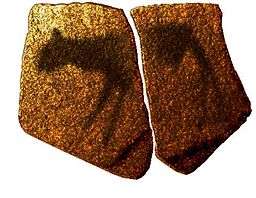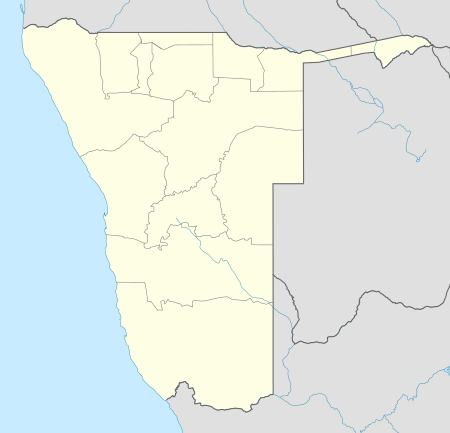Apollo 11 Cave
The Apollo 11 Cave is an archeological site in the ǁKaras Region of south-western Namibia, approximately 250 km (160 mi) southwest of Keetmanshoop. The name given to the surrounding area and presumably the cave by the Nama people was “Goachanas”.[1] However, the cave was given its name by German archaeologist Wolfgang Erich Wendt who was working in the cave when he heard of the Apollo 11 crew's successful return to Earth on July 24, 1969.[2]
| Apollo 11 Cave | |
|---|---|
 Stone slab drawings from the Apollo 11 Cave in Namibia. Created c.25,500 - 25,300 years ago. | |
 | |
| Location | Keetmanshoop, Namibia |
| Coordinates | 27°45′S 17°6′E |
| Geology | quartzite |
Overview
The cave contained some of the oldest pieces of mobile art ever discovered in southern Africa, associated with charcoal radiocarbon dated from 27,500 to 25,500 BP. The slabs found in the cave are referred to as the Apollo 11 Stones.[3] In total, seven grey-brown quartzite slabs were excavated from the cave. Besides the slabs, the cave contained several white and red paintings. The subject of paintings ranged from simple geometric patterns to bees, which are still a nuisance to the unwary traveler.[1]
Art was also found near the cave in the form of engravings, on the banks of a riverbed, and on a large limestone boulder located 150 m (490 ft) from the cave. The engravings consisted of depictions of animals as well as simple geometric patterns. It is hard to pinpoint dates of the engravings and paintings, but the paintings may belong to period as far back as 10,400 BP and the engravings may come from early settlers in the first millennium AD. These dates come from Wendt's stratigraphic record of the site as well as evidence from other sites in the surrounding area.[1]
More recent finds include two rib pieces (one with 26 notches; the other with 12 notches) dated to 80,000 BP.[4]
See also
References
- John Mason, "Apollo 11 Cave in Southwest Namibia: Some Observations on the Site and Its Rock Art" The South African Archaeological Bulletin, Vol. 61, No. 183 (Jun., 2006), pp. 76-89
- Wiebke Schmidt: Auf den Spuren der ältesten Kunst. Archived 2013-10-04 at the Wayback Machine Allgemeine Zeitung, May 2, 2008
- Hager, Natalie (2015). "Apollo 11 Stones". Khan Academy. Retrieved February 14, 2017.
- Ralf Vogelsang; Jürgen Richter; Zenobia Jacobs; Barbara Eichhorn; Veerle Linseele; Richard G. Roberts (2010). "New Excavations of Middle Stone Age Deposits at Apollo 11 Rockshelter, Namibia: Stratigraphy, Archaeology, Chronology and Past Environments". Journal of African Archaeology. Academia. 8 (2): 185–218. doi:10.3213/1612-1651-10170. Retrieved February 22, 2017.
Further reading
- John C. Vogel: Suitability of Ostrich eggshell for radiocarbon dating. Radiocarbon, Bd. 43 (1), S. 133–137.
- Tilman Lenssen-Erz, Marie-Theres Erz, Gerhard Bosinski (Hrsg): Brandberg. Der Bilderberg Namibias, Kunst und Geschichte einer Urlandschaft. Jan Thorbecke Verlag, Stuttgart 2000, 3-7995-9030-7, S. 89.
- Ralf Vogelsang: The Rock-Shelter „Apollo 11“ – Evidence of Early Modern Humans in South-Western Namibia. In: Megan Biesele, Cornelia Limpricht (Hrsg.): Heritage and Cultures in Modern Namibia: In-depth Views of the Country. TUCSIN-Festschrift, Klaus Hess Verlag, Windhoek Göttingen 2008, ISBN 978-3-933117-39-7, S. 183–193.
- Ralf Vogelsang et al.: New Excavations of Middle Stone Age Deposits at Apollo 11 Rockshelter, Namibia: Stratigraphy, Archaeology, Chronology and Past Environments. Journal of African Archaeology 8 (2) 2010, pp. 185-218.